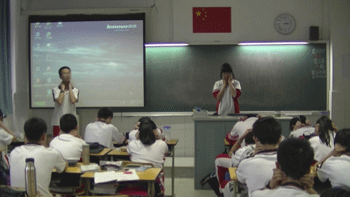Since modernization, "events" and "things" that take place in the education system are often similar in each country. Therefore, it is possible for Chinese people to imagine features of Japanese schools and student life even if they have never spent time in Japanese schools. However, what we understand to be "the same event" or "the same thing" is sometimes slightly different or country-specific when we examine it or listen closely.
One day, when I was studying in Beijing (8 years ago), I was talking with a Chinese student studying in the education department and suddenly wondered whether schools hold morning assemblies. I explained that in Japanese schools, a morning assembly is held about once a week, where the principal delivers a message and makes announcements regarding the entire school. Then she asked me curiously, "By the way, when does hoisting of the national flag take place? You do raise your flag, right?"
From my apartment in Beijing where I now live, I am able to see the playground of a junior high school where I often hear the national anthem during school events. In addition, about once a week, all the students of the school gather to raise the national flag while the national anthem is playing in the background. On the other hand, compared with Chinese schools, in Japanese schools, it is rare to see the national flag raised or to hear the national anthem. As for public schools, the Ministry of Education, Culture, Sports, Science and Technology in Japan has given guidance to raise the flag and to sing the national anthem during entrance and graduation ceremonies: and the compliance rate has become close to 100% over the past 15 years or so. However, there are also many private schools in Japan, and I suspect that the compliance rate is lower in the private schools. Not to mention, I suppose that such rituals are much less likely to take place in such schools.
Of course, there are differences in what kind of events take place in Japanese and Chinese schools. When we compare the schedule of schools in both countries, we can see that some events are country-specific. For example, as I was putting away a video recorder that I was using while touring a junior high school, calm music started to play. A female student stepped towards the platform and started making a "strange movement" to the music (that's how it seemed at that time), and the noisy classroom suddenly became quiet. All the other students in the classroom made the same movement.

Scene of "eye exercise"
Although I had heard of "eye exercise" in Chinese schools, this was the first time to see it with my own eyes. Surprised, I turned the video back on. I have heard that "eye exercise" in Chinese schools, which is conducted for the health of the eyes, is influenced by education in the former Soviet Union. It is an event with a historical background. For a long time, and even today, this event, which has never included in the daily schedule at Japanese school, takes place during a certain period of time in the afternoon (between classes). In Chinese schools, all students gather between class in the morning for exercise time,(This is similar to time for radio calisthenics in Japan. School assemblies also often take place "between class.") and students have "eye exercise" in the afternoon. School seems to play a central role in the health management of children/students in China. There also seems to be less emphasis on building physical strength in Japan.
On the other hand, when explaining the schedule at Japanese school to Chinese, it is necessary to also explain "morning reading (Chinese schools have a similar subject, but it often refers to studying with textbooks)" and "school-provided lunch." In addition, for example, when referring to "cleaning," it is necessary to explain the extent of students' involvement in cleaning and their roles, because in China, adults also do the cleaning in school in addition to children/students.
These differences in the "events" and "things" within schools are not simply a matter of differences in "living environments surrounding the students that are different from country to country"; they are also responsible for major differences in the school life and psychology of the students.
For example, when we ask Chinese university students about their memories of junior high school and high school, we often hear of the word Tong-zhuo, if translated literally, means "same desk." "Desk" literally signifies a desk, but does not refer to the object that is a desk, but rather to "the classmate who shares the same desk." "Same desk" does not refer to two students sharing a small desk (the type seen in Japanese schools) in turn, but to two desks that are put together for the two students to use together. The relationship of the two people that share the desk becomes naturally deeper as the students spend the whole day in intimate proximity. In Japan, two desks are placed together in elementary schools, but this is not often the case in junior high school and high school.
The following (Watanabe, 2007) is a part of an interview with a Chinese graduate student talking about the experience of university entrance exams. For this person A, the deskmate served as a competitor and a source of motivation to study harder as well as a source of stress.
A: My deskmate and I were classmates, but our relationship in the dormitory was not good. The reason is that we were about the same level and always competing. The closer the grades, the more one wants to compare. After a test, if she got a 90, and I got an 89, I felt bad. This is not the case between good friends.
However, if the relationship is good, it's possible to become best friends. In some cases, members of the opposite sex share the same desk.
B: Oh, in one instance, I become good friends with my deskmate. I shared a desk with a boy, who later became my boyfriend.
I: In the third year of high school?
B: Then, we were not in love yet, but fell in love in university.
In any case, whether it be a competitive relationship, or close friend, sharing a desk in school life, leads to an important relationship in school. At the same time, it is an unforgettable, important memory of school life.
To begin with, it is hard for me as a Japanese to understand why the desk must take this form. I attempted to ask a Chinese friend, but he himself did not know the reason and replied "but it's convenient to talk to a classmate. If we sat apart, it we would be difficult to speak with each other." He reasoned that "Chinese like to cooperate when doing many things, and maybe it's to teach that." Unexpectedly, the form of the desk in the classroom may reflect the fundamental differences in how people put the distance between each other both physically and mentally.
When comparing the lifestyle and psychology of children in Japan and China, the reality of daily life may be seen by comparing the specific "events" and "things" that surround children. These "events" and "things" are often similar to the structure of the society and reflect its history. Therefore, the features of a country's education and society may come into view when we look into the shape and position of the "things" and the way the "events" take place and develop. However, understanding these "events" and "things" requires a certain level of "literacy" or background knowledge. For this reason as well, we must build up communication in daily conversation as we talk about our "events" and "things."
-
Reference:
- Watanabe, T. (2007). A qualitative study of human relationships regarding university entrance exam examinees: A comparison of China and Japan. Proceedings of the 11th Annual Meeting of the Chinese Psychological Society, 174.



 Tadaharu Watanabe, M.Ed., Tokyo University, Graduate School of Education. Ed.D., Beijing Normal University, School of Psychology, Research Institute for Developmental Psychology.
Tadaharu Watanabe, M.Ed., Tokyo University, Graduate School of Education. Ed.D., Beijing Normal University, School of Psychology, Research Institute for Developmental Psychology. 










